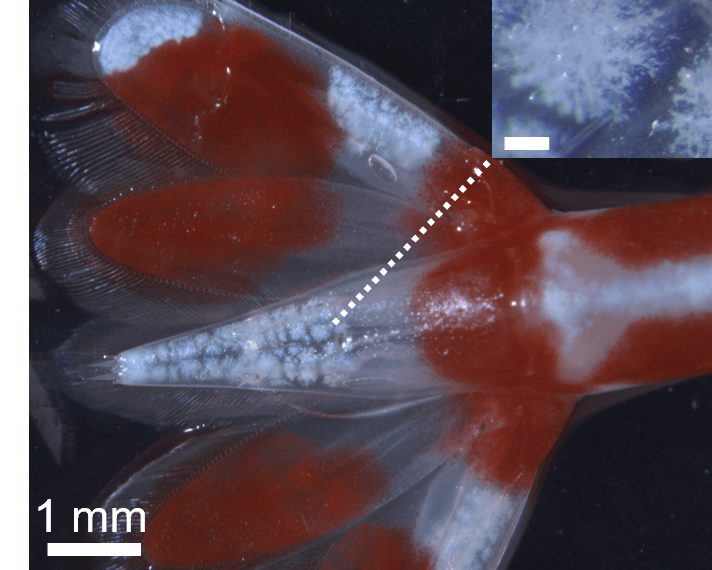The shrimp has a particularly bright white color on its back and limbs that are intended to attract fish, which it 'cleanses' of pests it feeds on. An in-depth examination of the white substance using special electron microscopes revealed that the substance consists of an incredibly thin layer of very dense nanospheres (spheres of very tiny diameter)

When you look at nature, you can understand new laws. This is exactly what happened to researchers from Ben-Gurion University of the Negev who tested a substance that creates a white color in shrimps and discovered that it has properties that make it brighter than other substances. The discovery is considered a scientific achievement since it forms the basis of a new principle in the field of optics that can be used to invent new materials. The research findings were published in the prestigious journal Nature photonics.
In the world of chemistry today there is a challenge - producing a white substance that is environmentally friendly and not harmful to health, that is bright enough and as thin as possible. why? Inorganic particles (such as titanium dioxide and zinc oxide) are widely used as bleaching agents in foods, cosmetics and paints. However, due to the concern that these substances carry with them health hazards, there is currently an extensive search for environmentally friendly organic substances so that these substances can be replaced in a healthier way. Now, with the findings of the new study, it is possible that the substance that causes the bright white color in shrimps is the one that will answer the global challenge.
The master's thesis of Tali Lemkof accompanied Dr. Ben Palmer from the chemistry department at Ben-Gurion University of the Negev, focused on investigating the substance that creates white color in shrimps. The shrimp has a particularly bright white color on its back and limbs that are intended to attract fish, which it 'cleanses' of pests it feeds on. An in-depth examination of the white substance using special electron microscopes revealed that the substance consists of an incredibly thin layer of very dense nanospheres (spheres of very tiny diameter).
The key to this special optics is in the arrangement of the molecules in the nanometers, in the spheres that make it up. The molecules are arranged as a 'liquid crystal', an arrangement in which stacks of molecules are arranged in columns radiating from a common central point in the center of the nanosphere, just like the spokes of a wheel. The arrangement gives the nanometers an optical property called birefringence. It turns out that the arrangement of the molecules and the birefringence are the key to overcoming the obstacle that reduces the reflection of light. The double amplification makes it possible to pack the nanometers densely and reduce the thickness of the layer required to produce a bright white material. The production of thick white material exists in nature and in industry, but preparing a material that reflects bright white light that is thin, is a challenge due to a phenomenon that causes a decrease in the amount of light that is reflected from overly dense and thin materials. The research revealed that although the material produced in the shrimp is only 5 microns (millionths of a meter) thick, it manages to reflect white light in an extraordinary way that makes it one of the substances that reflect white light most effectively in nature.
"At first I thought it was not interesting because the nanometers were not arranged like classical crystals, in long-range three-dimensional order. But when we looked closely using electron microscopes, we realized not only that the particles are liquid crystals, like those found in LCD displays, but that they have double refraction, which is very rare in the living world." told Tali Lemoff.
This discovery is of great importance because it changes assumptions and laws from the world of optics. "This is really one of the first times we have learned a completely new principle from the study of an organism. The shrimp overcame a fundamental obstacle in optics by creating nanometers with this special arrangement of molecules. Now the question is how we can reproduce this effect to create new materials that we can use as a food additive in white bread, or in white paint and other applications," said Dr. Palmer.
This research was supported by the ERC, the European Union's Horizon 2020 research and innovation program, a grant from the Swiss National Science Foundation, and an HFSP grant (No. RGP0037/2022) awarded to Dr. Ben Palmer. Dr. Palmer is the winner of the Nahum Guzik grant and the winner of the Azrieli scholarship for young faculty for 2019. Electron microscope research is supported by the Ilse Katz Institute for Nanoscale Science and Technology at Ben-Gurion University of the Negev.
The research group included: Dr. Ben Palmer, Tali Lemkoff, Avital Wagner, Dr. Gan Zehang - from the Department of Chemistry, Dr. Mariela Pavan - Ilza Katz Institute for Nanoscale Science and Technology, all at Ben-Gurion University of the Negev. Lotem Elos, Prof. Dan Oron - Weizmann Institute. Dr. Johannes Hetja - Cambridge University, United Kingdom, and Aalato University, Finland. Dr. Lucas Schertel - University of Cambridge, UK and University of Fribourg, Switzerland. Dr. Venkata Jaisoriya Yalpargade - Indian Institute of Technology. Prof. Silvia Vignolini - University of Cambridge, United Kingdom.
